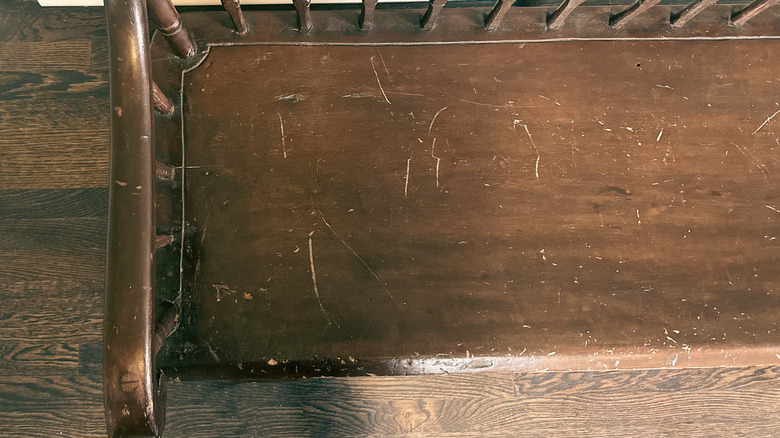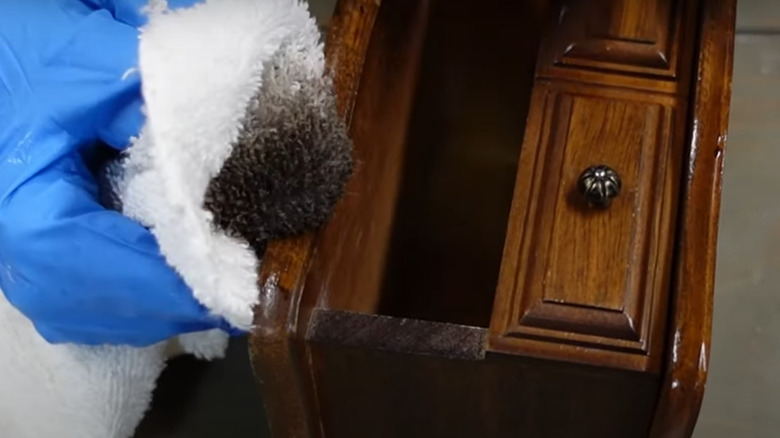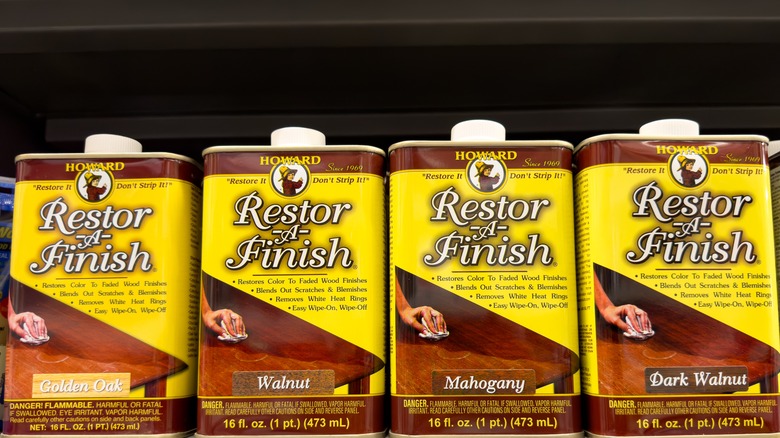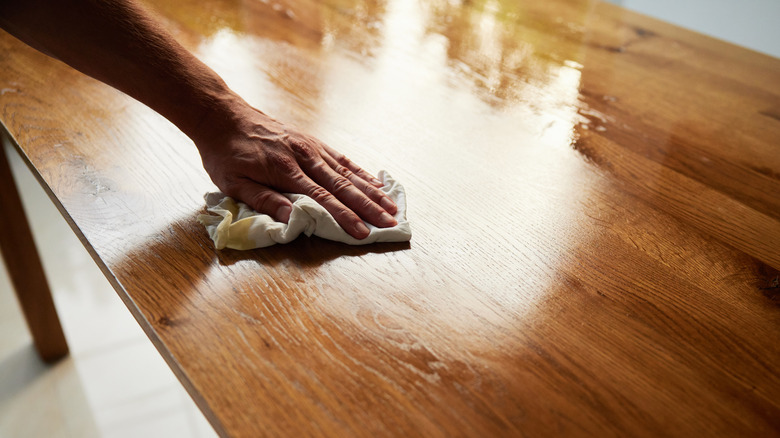Is Restor-A-Finish A Miracle Product For Your Scratched Up Furniture?
We may receive a commission on purchases made from links.
As a professional woodworker, the question of dealing with scratched and degraded finishes is perhaps the most frequent inquiry folks have for me. And it makes sense. Wooden furniture pieces last forever, but their finish takes a beating. Scratches, stains, and water will disfigure our favorite pieces, and it's hard to know if any specific at-home remedy for wood furniture problems will actually fix anything (or just make it worse). Is there a magic wand that you can wave over the finish and fix it faster than you can say Harry Potter? Or more realistically, is Howard's Restor-A-Finish a miracle product that will repair your damaged furniture finishes?
Well... yes, no, and maybe? Before I tell you more about Restor-A-Finish, let's talk about how finishes work on furniture. Most wood finishes are what is called a "film coat" — a product that builds up a thin layer on top of the raw wood. Lacquer, shellac, varnishes, and the various types of polyurethanes are the most common film finishes on traditional furniture. These film coats are transparent, allowing you to see the wood underneath, but they also protect the raw wood from soaking up moisture, as well as preventing oils, fats, stains, and dirt becoming embedded in the wood fibers.
We don't really see the film coat so much as see how light bounces off of it. We woodworkers call that a sheen. When that film coat gets scratched or degraded, what we notice is how differently those defects affect how the light bounces off the surface. And if the scratch goes through the film coat and harms the actual wood, that makes an even more dramatic flaw in the finish. Now that we have this in mind, let's look deeper into how well Restor-A-Finish actually works.
Here's what Restor-A-Finish actually does to your wood furniture
Restor-A-Finish works by essentially "melting" the existing finish, softening it sufficiently to allow surface cracks and scratches to meld back together, thus creating a new surface that reflects light uniformly. Because this product chemically interacts with the film coat, it will also remove or at least significantly improve heat marks (from setting a hot pan or tea pot on the finish, for example) or water rings. If a scratch goes through the finish and scrapes off the stain color, Restor-A-Finish will help hide that by coloring the wood fibers (and to do that, Restor-A-Finish comes in a wide variety of colors). The sheen will be less shiny than the original, but that's a minor concern in the grand scheme. Long story short, Restor-A-Finish is an amazing product and provides wonderful results.
To use it, first clean the surface with soap and water, then dry. Select a color of Restor-A-Finish that closely matches the hue of your furniture piece, then wipe on Restor-A-Finish by pouring the product onto a cloth and rubbing it onto the surface, starting with a circular motion and then wiping with the grain. Be sure to be in a well-ventilated area and use protective gloves — the latter will keep your fingers from getting stained the color of the furniture. If the scratches or other defects do not visually disappear, switch to 0000 steel wool (extra-fine) and apply more of the product, with a bit more elbow grease, rubbing with the grain. How much? I recommend using the Goldilocks' method: Not too hard, not too soft, just right!
When you are done wiping it on, wipe it off. It will take at least 24 hours to cure.
How (and why) Restor-A-Finish results can vary
Once the finish has cured you can inspect it to see the final results. From my professional experience, these vary across three main categories: First, If you had only minor damage without full-thickness scratches to the film coat, the surface will be smooth and nearly perfect. Second, if you had more significant damage, the surface will be hugely improved, with a uniform color and patina, but you will still see the shape of some scratches or cracks — and while this may sound disappointing, in reality, most people will be completely happy with these results. The third and final possibility is that your piece will be much cleaner, and with some color improvement, but mostly unchanged.
Why the variations? The difference between the first two results is essentially due to how badly the existing finish was damaged. While Restor-A-Finish will soften and meld some cracks and blemishes together, there is a certain point where it cannot repair the damage, only improve it. The last and most disappointing result can occur due to the type of clear coat finish that is on the furniture: Older furniture tends to have finishes like varnishes, shellac or nitro cellulous lacquer, and these finishes are what Restor-A-Finish repairs well. Unfortunately, finishes like catalyzed lacquer and polyurethane will not dissolve with the chemicals in Restor-A-Finish, and therefore will not be improved by the product.
For best results, follow up Restor-A-Finish with Feed-N-Wax
Now, what about after it's done? Do you apply another finish?
The Howard company recommends that you follow up a Restor-A-Finish treatment by using their Feed-N-Wax wood polish and conditioner, advice which I heartily endorse. Doing so will further improve the look of the furniture you've worked on. Why? Well, remember the reason we so clearly see the defects in a furniture's finish — the way that light bounces off the surface? This wax and oil mixture helps to create a more uniform surface which reflects light more evenly. As a side note, I use Feed-N-Wax on all my wooden furniture in my home and recommend it to my customers. In truth, though, any real furniture wax polish or product will do the same job.
I reached out to Casey Howard from Howard Products, Inc., about this, wondering the company's thoughts on applying another finish over the top of Restor-A-Finish. He offered the following piece of advice, which I'd recommend taking to heart: "You can apply [another finish over] the Restor-A-Finish, [but] wait 30 days, and then apply a waterproof finish (polyurethane, varnish, lacquer and any other finish that dries and cures). Keep in mind that the purpose of Restor-A-Finish is to restore an existing finish. We do not normally recommend applying a clear coat finish (other than wax) over Restor-A-Finish because Restor-A-Finish (or any oil) can cause a new finish to not dry correctly and it can ruin the finish."
Note his emphasis on waiting at least a month, and consider your intent and goals. It often is best to just stick with the recommended Feed-N-Wax process instead.



